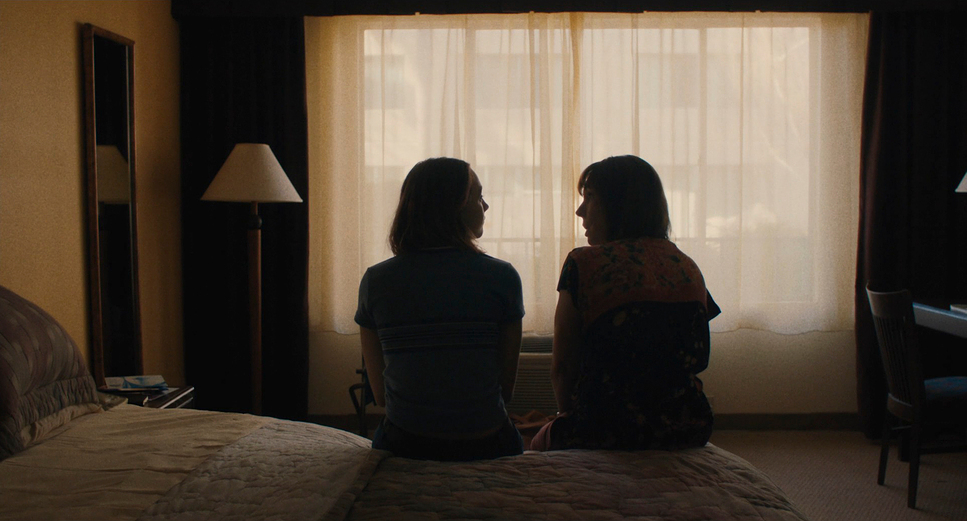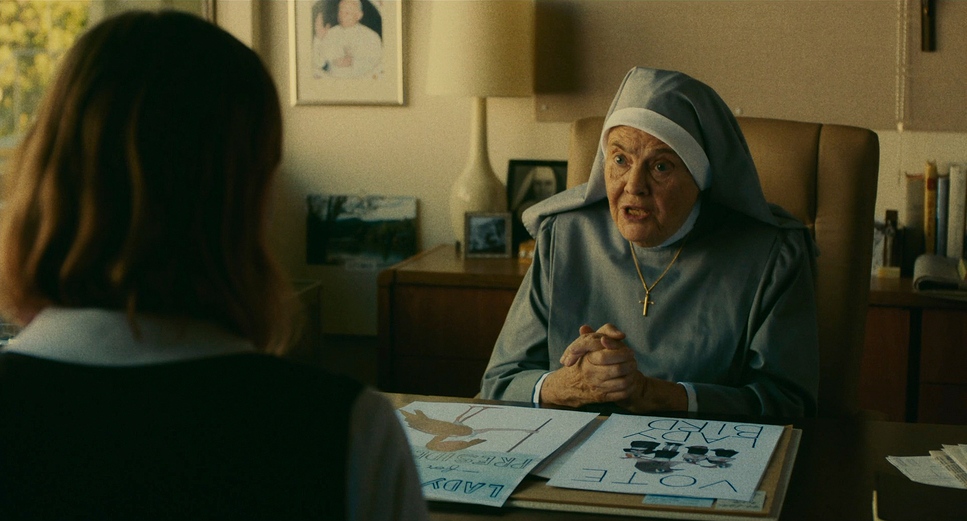My name is Salik Waquas, and I’m a passionate filmmaker and full-time colorist. I’ve spent years immersed in the world of visual storytelling, working with filmmakers to bring their visions to life through the art of color grading. I also run a post-production color grading suite, Color Culture, where I dive deep into the intricate relationship between visuals and narrative. In my articles, I explore the intersection of cinematography and storytelling, offering insights shaped by my experiences in filmmaking and color grading.
Lady Bird: A Cinematography Analysis
Greta Gerwig’s Lady Bird isn’t just a poignant coming-of-age tale—it’s a film brimming with visual nuance and intentionality. Cinematographer Sam Levy’s artistry transforms this personal narrative into a visual feast, skillfully using light, composition, and movement to enhance the film’s emotional depth. In this article, I’ll unpack the cinematographic choices in Lady Bird, sharing my thoughts as both a filmmaker and a colorist, to provide a closer look at how its visuals evoke emotion and memory.
About the Cinematographer

Sam Levy’s cinematography on Lady Bird reflects his talent for crafting visuals that feel deeply personal and relatable. His previous collaborations with Noah Baumbach on films like Frances Ha and Mistress America showcase his knack for portraying intimate, character-driven narratives. In Lady Bird, Levy and Gerwig form a partnership that combines technical prowess with heartfelt storytelling.
🎬 A Note from Salik:
I often get asked how I achieve the dense, filmic look in my commercial work. The secret isn't just color grading—it's the starting point. I have finally released my personal Master LUT Pack—8 distinct looks based on real film.
These aren't simple presets; they were crafted using complex math, empirical data, and precise tetrahedral operations to ensure technical integrity. This is the exact collection I've built over the years and used on 200+ high-end commercials.
*Compatible with Davinci Resolve, Premiere Pro, and FCPX.
Levy’s cinematography strikes a balance between analog warmth and modern precision, creating a hybrid aesthetic that perfectly complements Gerwig’s vision. By blending digital filmmaking techniques with a nostalgic, analog-inspired texture, he amplifies the film’s emotional resonance. It’s a testament to how cinematography can move beyond aesthetics to become a vital part of the storytelling process.
Inspiration for the Cinematography of Lady Bird

The inspiration for Lady Bird’s visual style stems from a desire to evoke memory and nostalgia, reflective of its early 2000s setting. Gerwig and Levy studied photographs and images from the era, including yearbooks and Xeroxed snapshots, to craft the film’s slightly faded, pastel look.
Wayne Thiebaud, a Northern Californian artist known for his pastel-hued paintings, heavily influenced the color palette. His work, which celebrates the beauty of the mundane, finds a visual parallel in the film’s soft blues, muted pinks, and serene river scenes. This palette reflects both the specificity of Sacramento and the universal nature of youthful longing.
Camera Movements Used in Lady Bird

The camera work in Lady Bird is a masterclass in restraint. Levy opts for a handheld style that captures the immediacy of Lady Bird’s world while maintaining an unobtrusive presence. This approach creates an intimate connection between the audience and the protagonist.
Dynamic camera movements heighten emotionally charged scenes, drawing viewers into Lady Bird’s perspective. Conversely, static shots are used during reflective moments, creating a sense of stillness that mirrors the character’s introspection. This balance between movement and stillness mirrors the tension in Christine’s relationship with her mother and her own internal struggles.
Compositions in Lady Bird

Levy’s compositions are deceptively simple yet brimming with emotional depth. Tight two-shots during arguments between Lady Bird and her mother emphasize their closeness, even amid conflict. These frames subtly remind us of the underlying love in their turbulent relationship.
In contrast, wide shots of Sacramento and its suburbs underscore Lady Bird’s feelings of confinement and her yearning for something greater. The use of negative space is particularly effective, visually conveying her sense of isolation and desire to escape. As a filmmaker, I found this approach poignant—it’s a visual representation of teenage angst and the universal search for belonging.
Lighting Style of Lady Bird

The naturalistic lighting in Lady Bird grounds its emotional moments in a sense of reality. Levy often relies on ambient daylight to create an authentic atmosphere. Soft, diffused light adds a dreamy quality to scenes that evoke nostalgia, while warm hues during sunset and golden hour visually underscore the bittersweet nature of growing up.
This lighting style bridges the gap between memory and immediacy, making viewers feel as though they’re watching events unfold from their own recollections. As a colorist, I deeply admire how the lighting choices seamlessly enhance the emotional tone of the film.
Lensing and Blocking of Lady Bird

Levy’s choice of an ARRI Alexa Mini paired with Leica lenses gives Lady Bird its crisp yet organic look. The wide lenses capture Sacramento’s suburban landscapes with a painterly touch, while also drawing viewers into the characters’ intimate moments.
Blocking plays a significant role in reflecting character dynamics. During confrontations, characters are often placed at opposite ends of the frame, highlighting their emotional distance. In moments of reconciliation, tighter blocking emphasizes closeness. This intentional choreography of movement and framing underscores the evolving relationships between characters.
Color Grading of Lady Bird

The color grading of Lady Bird is a key element in its nostalgic aesthetic. The pastel tones and desaturated colors create a subdued yet emotionally resonant palette. Blues and greens dominate, reflecting the film’s themes of longing and growth, while warm, earthy tones in home interiors evoke a sense of comfort and familiarity.
As a colorist, I found the meticulous grading particularly inspiring. The shift in color temperatures—from the warm interiors of Lady Bird’s home to the cooler tones of her school and city—emphasizes her yearning to break free from her current environment. These subtle yet effective choices elevate the storytelling.
Technical Aspects of Lady Bird
From a technical perspective, Lady Bird is a triumph of indie filmmaking. Although it was shot digitally, the film achieves the warmth and texture of analog cinema through post-production techniques, such as grain overlays and color adjustments. This analog-inspired look enhances its nostalgic tone, making the early 2000s setting feel authentic and lived-in.
The use of sound design and music further complements the visuals. Tracks like “Crash Into Me” by Dave Matthews Band ground the film in its specific time and place, adding another layer of authenticity.
Final Thoughts
Lady Bird exemplifies how cinematography can transform a film from a compelling story into an emotional masterpiece. Sam Levy and Greta Gerwig’s collaboration demonstrates that thoughtful choices in lighting, composition, lensing, and color can elevate a narrative’s emotional depth.
As a filmmaker and colorist, Lady Bird is a source of constant inspiration. It reminds me that cinematography isn’t just about creating beautiful images—it’s about crafting visuals that resonate with authenticity and emotion. The film is a love letter to family, identity, and home, and its visual storytelling ensures its place as one of the most heartfelt coming-of-age stories of our time.
- Also Read: CINEMATOGRAPHY ANALYSIS OF JOJO RABBIT (IN DEPTH)
- Also Read: CINEMATOGRAPHY ANALYSIS OF JAWS (IN DEPTH)
Browse Our Cinematography Analysis Glossary
Explore directors, cinematographers, cameras, lenses, lighting styles, genres, and the visual techniques that shape iconic films.
Explore Glossary →